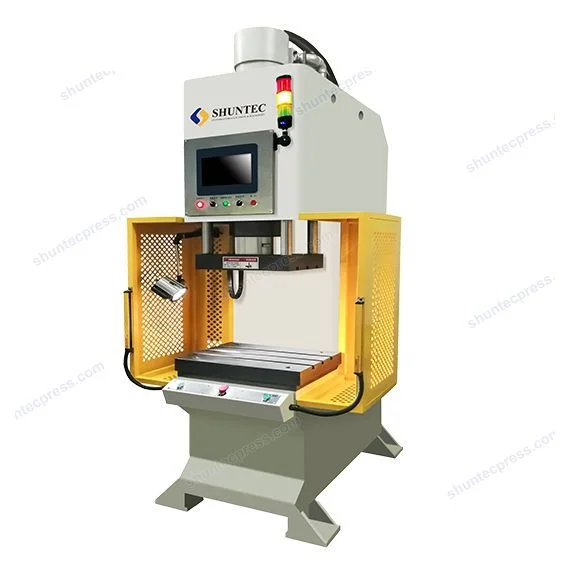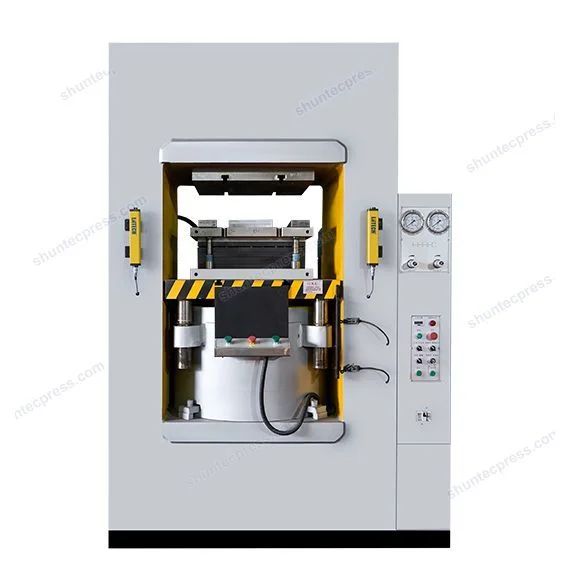A 100 ton hydraulic press is one of the most versatile machines in modern metal forming, manufacturing, and assembly operations. Built to deliver up to 100 tons of compressive force, it enables precise pressing, bending, straightening, punching, and deep-drawing of various materials—from steel and aluminum to composites and plastics.
In recent years, this tonnage has become the preferred choice for medium-scale production lines, automotive workshops, and custom part manufacturers who need a perfect balance between power, efficiency, and footprint.
This guide explains what a 100 ton hydraulic press is, how it works, what applications it serves, and how to choose the right model for your production needs—helping you make an informed investment for long-term performance.
What Is a 100 Ton Hydraulic Press?
A 100 ton hydraulic press is an industrial machine designed to apply up to 100 tons of compressive force using a hydraulic cylinder powered by pressurized oil. It operates based on Pascal’s Law — when pressure is applied to a confined fluid, it is transmitted equally in all directions — allowing the press to generate massive, uniform force with minimal input.

Structurally, a 100 ton press usually consists of a sturdy steel frame (H-frame or C-frame), a hydraulic cylinder and ram, an oil reservoir and pump system, and control valves that regulate pressure and movement. Some models feature double-acting cylinders for faster retraction or servo-hydraulic systems for improved precision and energy efficiency.
This capacity range—100 tons—is ideal for medium to heavy-duty metal forming tasks, including bending, pressing, punching, and straightening. It provides high stability and consistent pressure across the stroke, making it a preferred choice for manufacturers who need both strength and control in their production processes.
Why Choose a 100 Ton Hydraulic Press?
Choosing a 100 ton hydraulic press means selecting a machine that offers an ideal balance between force, size, and versatility. It delivers enough pressing power to handle most metal forming, assembling, and maintenance tasks without the excessive cost or footprint of larger presses.
For manufacturers in automotive, appliance, metal fabrication, and aerospace sectors, the 100-ton capacity is particularly attractive. It can easily perform operations like deep drawing, straightening, punching, forming, and press fitting on components such as brackets, gears, bearings, or sheet-metal parts.
Compared with smaller presses (20 – 50 tons), it provides the additional strength required for medium-to-heavy workloads while maintaining precise control and safety. At the same time, it is far more energy-efficient and space-saving than massive 200- or 300-ton machines, making it suitable for small-to-medium workshops.
Many modern 100-ton presses now integrate servo-hydraulic systems, CNC controls, and programmable pressure settings, enabling repeatable accuracy and faster cycles. This flexibility allows the same machine to serve multiple applications—whether you are producing industrial components, performing repair work, or running a custom tooling shop.
In short, the 100 ton press represents the sweet spot of hydraulic power—strong enough for demanding production, yet compact and cost-effective for daily operation.
Advantages and Limitations
A 100 ton hydraulic press offers an excellent combination of power, precision, and adaptability for a wide range of manufacturing and maintenance operations. Its key advantages include:
- High pressing force with precise control: The hydraulic system allows smooth and adjustable pressure throughout the stroke, ensuring accuracy even for delicate components.
- Versatility: Suitable for bending, forming, assembling, and straightening tasks across multiple industries.
- Compact and efficient design: Compared to larger presses, it saves space while maintaining substantial power output.
- Cost-effectiveness: Provides strong performance at a moderate investment level, making it accessible for small and medium manufacturers.
- Safety and consistency: Equipped with overload protection, safety valves, and programmable controls for reliable operation.
However, there are also limitations to consider:
- Slower cycle speed compared to mechanical or servo presses, which can impact high-volume production.
- Regular maintenance is required to prevent oil leaks or hydraulic system wear.
- Energy consumption may increase under continuous high-pressure operation.
In summary, the 100 ton hydraulic press provides outstanding force and flexibility for most applications, but it’s best suited for operations prioritizing precision, durability, and controlled productivity over extreme production speed.
How to Choose the Right 100 Ton Hydraulic Press
Selecting the right 100 ton hydraulic press requires more than just checking the tonnage. The optimal choice depends on your materials, production volume, precision needs, and workspace conditions. Here are the main factors to consider:
1. Frame Design (Structure Type):
- H-frame presses provide higher rigidity and even pressure distribution, ideal for heavy-duty forming.
- C-frame presses offer better accessibility and are suitable for assembly or repair tasks where space is limited.

2. Cylinder & Stroke Capacity:
- Check the stroke length, daylight (opening height), and ram diameter to ensure compatibility with your workpiece size and forming depth.
- For deeper or multi-step forming, a longer stroke and adjustable pressure are essential.
3. Power System:
Choose between manual, air-hydraulic, or electric servo-hydraulic systems. Servo models provide superior precision, energy savings, and automation compatibility.
4. Control & Safety Features:
Look for pressure gauges, programmable logic control (PLC), and safety interlocks to enhance operator protection and repeatability.
5. Production Needs & Budget:
Estimate your daily workload and duty cycle. A shop press used occasionally may not require advanced automation, while continuous production benefits from CNC control and faster cycle speeds.
6. After-Sales & Maintenance Support:
Reliable suppliers offer training, spare parts, and on-site maintenance — factors that ensure long-term productivity.
Ultimately, the best 100 ton hydraulic press is one that fits your workflow — powerful enough to handle your toughest jobs, yet efficient and easy to maintain. Always request a detailed quotation and specification sheet before purchasing.
Operation and Maintenance
Operating a 100 ton hydraulic press safely and efficiently requires strict adherence to maintenance and inspection routines. Proper handling not only ensures consistent performance but also extends the lifespan of key components.
Operation tips:
- Always check oil levels, pressure settings, and safety locks before starting the machine.
- Make sure the workpiece is centered on the platen to prevent uneven force or ram misalignment.
- Avoid overloading beyond rated capacity — even short bursts can damage seals or cylinders.
- Use protective guards and emergency stop controls at all times.
Maintenance best practices:
- Replace hydraulic oil every 6–12 months or after 2,000 hours of operation.
- Inspect hoses, seals, and fittings regularly for leaks or cracks.
- Keep the filter and cooling system clean to maintain fluid efficiency.
- Calibrate pressure gauges annually and test safety valves periodically.
By combining daily checks with scheduled maintenance, you can keep your 100 ton press operating smoothly, safely, and productively for years.
Case Study: Deploying a 100 Ton Hydraulic Press in a Metal Stamping Factory
Imagine you are running a metal stamping factory that produces precision brackets, frames, and automotive components. You need a machine strong enough to handle 3 mm-thick steel sheets yet flexible for small batch customization.
A 100 ton hydraulic press becomes the perfect centerpiece of your forming line. You configure it with an H-frame structure for stability, a programmable pressure control system for repeatable results, and a servo-hydraulic drive to reduce energy consumption during idle cycles.
The press is integrated into a semi-automated workflow: feeding units deliver pre-cut blanks to the press table, where each cycle applies consistent pressure for bending or embossing. Operators monitor real-time parameters through a digital panel, ensuring uniform product quality.
After just a few weeks, production efficiency improves by over 30 %, scrap rates decrease, and tooling wear is reduced thanks to smooth hydraulic motion.
This setup demonstrates how a properly configured 100 ton press can transform mid-scale stamping operations—balancing power, precision, and cost efficiency for modern manufacturing demands.
FAQs
1. What materials can a 100 ton hydraulic press handle?
It can form metals like steel, aluminum, copper, and brass, as well as non-metals such as rubber and composites.
2. Is a 100 ton press suitable for continuous production?
Yes, especially servo-hydraulic or CNC-controlled models designed for stable cycle operation.
3. How much does a 100 ton hydraulic press cost?
Prices typically range from $8,000 to $25,000, depending on configuration and automation level.
4. What maintenance does it require?
Regular oil replacement, seal inspection, and calibration of pressure gauges every 6–12 months.
5. Can it be customized?
Absolutely. Many manufacturers offer custom frame sizes, stroke lengths, and automation integration.
Conclusion
A 100 ton hydraulic press strikes the ideal balance between strength, precision, and cost-efficiency — making it one of the most dependable machines in modern metal forming. Whether you’re producing automotive components, industrial tools, or custom metal parts, this tonnage offers the flexibility and control required for consistent results.
If you’re planning to upgrade your production line or explore custom hydraulic solutions, now is the time to take action.
👉 Contact Shuntec Press today for expert consultation, tailored configurations, and factory-direct pricing.
Empower your manufacturing with technology that delivers — reliable, efficient, and built to last.
